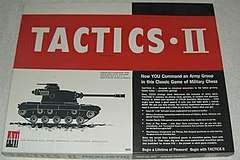Tactics (game)
 Tactics II (1958) | |
| Other name(s) | Tactics II |
|---|---|
| Manufacturer(s) |
Monarch Services J.E. Smith & Co.[1]:175 |
| Designer(s) | Charles S. Roberts |
| Publisher(s) | Avalon Hill Games |
| Publication date |
1954 II: 1958 |
| Years active |
1954-1958 II: 1958-1972, 1973-1998 |
| Genre(s) | war |
| Language(s) | en |
| Players | 2 |
| Playing time | 120 minutes |
Tactics is generally credited as being the first commercially successful board wargame.[2][3]
History
The section which follows is a direct quote taken from [4]. This section is under the 1952 Heading. "Commercial board wargames originated in 1952 with the publication of TACTICS by Charles S.Roberts. Avalon Hill did not exist then, but this event constituted the sowing of the initial seed. Roberts sold the game on a mail order basis from his home address at 305 Gun Road in Baltimore for the next six years. Primitive by almost anyone's current standards, it was nonetheless the birth of the hobby we know today. Published by the "Avalon Game Company"-a nom de plume Roberts used for his nonincorporated cottage industry, TACTICS was, of course, the forerunner of TACTICS II which most hobby followers mistakenly credit as the first commercial wargame. "Avalon" was decided upon simply because Roberts lived in a section of Baltimore referred to by that name. Later, in 1958 when Roberts incorporated the firm, the name was lengthened for aesthetic purposes to "Avalon Hill"-the "hill' owing its inspiration to the fact that 305 Gun Road was not only located in Avalon, but was also atop a hill."
It was designed by Charles S. Roberts in 1953,[5][6] and self-published in 1954 under the company name of The Avalon Game Company (later changed to Avalon Hill in 1958).[7] Tactics II, a revised version published by Avalon Hill in 1958, then re-released again in 1961 and 1973. In 1972, the game was discontinued due to rising costs, but was redesigned in 1973 with less costly components and used as a loss leader as it was an introductory wargame.[8] In 1983 Avalon Hill released a "25th anniversary" edition of the original Tactics, which did (for the first time) include the second map.
Play
Tactics pioneered many game mechanics which became standard in the board wargame industry, including the odds-ratio combat results table and variable movement costs for entering squares (later hexes) containing different types of terrain. It also evolved the use of cardboard counters which had been previously introduced with the game War Tactics or Can Great Britain Be Invaded?.[9] Unlike later board wargames which used a hexagonal grid superimposed on the game map, Tactics used a square grid. Pieces include the Armored units, Headquarter units, regular units, and specialized units consisting of mountaineers, para-troopers, and amphibious units.
References
- ↑ Shannon Appelcline (2011). Designers & Dragons. Mongoose Publishing. ISBN 978-1-907702- 58-7.
- ↑ Christopher Lewin, War Games and their History, Chapter 8, Fonthill Media, Stroud (GB) 2012, ISBN 978-1-78155-042-7
- ↑ James Dunnigan (1991). "Chapter 5". The Complete Wargames Handbook (2nd ed.). Archived from the original on 16 February 2009. Retrieved 5 February 2017.
- ↑ Avalon Hill's General Magazine Index and Company History 1952-1980 Volume 1- Volume 16 page5
- ↑ Wired Magazine March 2013, Page 70
- ↑ David W. (May 22, 2017). "WARGAMES 101: OR, "HOW YOU CAN LEARN TO STOP WORRYING AND LOVE CONSIMS"". The Daily Worker Placement. Retrieved September 9, 2018.
- ↑ Rienzi, Greg (May 2009). "Baltimore Observed: Encounter". The Urbanite Magazine. Urbanite Baltimore. p. 35. Archived from the original on June 8, 2009. Retrieved 2009-05-11.
- ↑ "The General Index and Company History". The General Magazine Index and Company History: 6. 1980. Retrieved August 5, 2015.
- ↑ War Tactics or Can Great Britain be Invaded? at the Imperial War Museum